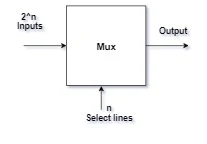In the realm of digital circuits, understanding the nuances between Multiplexer and Demultiplexer is pivotal for anyone delving into the intricacies of electronic systems. In this comprehensive guide, we dissect the functionalities, use-cases, and key differentiators between these two essential components.
Multiplexer: The Data Conductor
Multiplexer, often abbreviated as MUX, is a versatile component that plays a crucial role in combining multiple input signals into a single output. Think of it as a traffic conductor for data, efficiently merging various streams onto a unified highway.
Operation and Functionality
The fundamental principle behind a Multiplexer is its ability to select one input from multiple sources and direct it to the output. Employing logical control signals, it acts as a data switch, seamlessly routing information with precision.
Use-Cases
Multiplexers find applications in diverse fields, from telecommunications to computer memory systems. Their efficiency in consolidating and transmitting data makes them indispensable in scenarios where the optimization of resources is paramount.
Demultiplexer: Data Distribution Maestro
On the flip side, we encounter Demultiplexer, or DEMUX, a counterpart to the multiplexer but with a distinct purpose – the distribution of data. Imagine it as a dispatcher directing traffic to its designated lanes.
Operation and Functionality
Demultiplexers operate by taking a single input and distributing it across multiple outputs based on control signals. They act as data distributors, ensuring that information reaches its intended destination with accuracy.
Use-Cases
In scenarios where the demultiplication of data is imperative, such as in data communication networks, Demultiplexers come into play. They facilitate the organized distribution of information, contributing to the seamless functioning of various systems.
The Key Differences
Selection Mechanism
Multiplexers thrive on a selection mechanism where one input is chosen from several sources. On the other hand, Demultiplexers distribute a single input to multiple outputs.
Control Signals
While both components utilize control signals, Multiplexers employ them to select a specific input, whereas Demultiplexers utilize these signals to determine the output destination.
Applications
Multiplexers are prevalent in scenarios requiring data consolidation, like signal transmission. Conversely, Demultiplexers find their niche in situations demanding the organized distribution of information.
Advantages and Considerations
Multiplexer Advantages
- Efficient use of resources.
- Simplifies complex data transmission.
- Reduces the number of required channels.
Demultiplexer Advantages
- Facilitates organized data distribution.
- Enhances the reliability of information transmission.
- Streamlines data communication networks.
Key Difference Between Multiplexer and Demultiplexer
Multiplexer |
Demultiplexer |
|---|---|
| It is also called as a Data Selector or Mux | It is also called as a Data Distributer or Demux |
| Multiple inputs and a single output. | Single input and Multiple outputs. |
| It is used for Parallel to serial conversion | It is used for Serial to parallel conversion. |
| Types:4:1, 8:1, 16:1, 32:1 mux etc | Types:1:4, 1:8, 1:16, 1:32 demux etc |
| Combines multiple inputs into a single output. | Distributes a single input to multiple outputs. |
| Selects one input from multiple sources based on control signals. | Takes a single input and distributes it to specific outputs based on control signals. |
| Used in signal routing, data transmission, and multiplexing. | Commonly employed in broadcasting, data communication networks, and demultiplexing. |
| Control signals determine which input is selected for output. | Control signals determine the output destination for the given input. |
| Optimizes resource usage by combining multiple inputs. | Enhances resource efficiency by distributing a single input to specific outputs. |
| Operates in real-time, providing immediate output based on control signals. | Also operates in real-time, ensuring accurate distribution of data. |
| Can be more complex due to managing multiple inputs. | May be less complex as it primarily deals with distributing a single input. |
| IC 74151 is an example of a Multiplexer IC. | IC 74138 is an example of a Demultiplexer IC. |
 |
| Multiplexer |
 |
| Demultiplexer |
FAQs:
Q1: How do Multiplexers optimize resource utilization?
Answer: Multiplexers optimize resource utilization by efficiently consolidating multiple input signals into a single output, reducing the need for separate channels.
Q2: What role does a Demultiplexer play in data communication networks?
Answer: Demultiplexers facilitate organized data distribution in communication networks, ensuring information reaches its intended destinations without interference.
Q3: Can a system use both Multiplexer and Demultiplexer?
Answer: Absolutely, many systems leverage both components to balance the consolidation and distribution of data, catering to diverse application needs.
Q4: What advantages do Demultiplexers offer in information dissemination?
Answer: Demultiplexers enhance the reliability of information transmission by ensuring that data is accurately distributed to its intended recipients.
Q5: How do Control Signals work in Multiplexers?
Answer: Control Signals in Multiplexers determine which input gets selected and transmitted to the output, enabling precise data routing.
Q6: Are there specific industries where Demultiplexers are more commonly used?
Answer: Demultiplexers find prominent usage in industries requiring meticulous information dissemination, such as broadcasting and data communication networks.
Conclusion: Navigating the Digital Highway
In the intricate landscape of digital circuits, the distinction between Multiplexer and Demultiplexer is akin to understanding the lanes of a digital highway. While Multiplexers efficiently merge data streams, Demultiplexers ensure the organized distribution of information. The synergy between these components is integral to the seamless operation of electronic systems.
Post a Comment